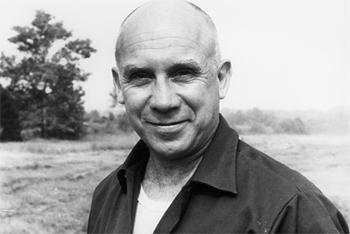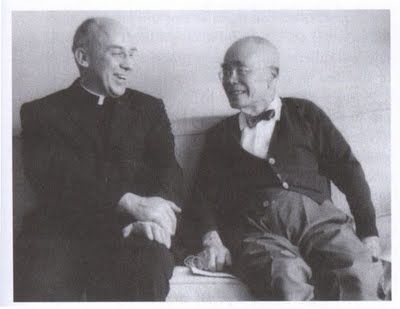Tillich's Theological Influence on Thomas Merton
(1915-1968)
|
 |
|
Photo of Thomas Merton by
Robert Lax (from
here) |
The formative theology of
Protestant theologian, Paul Tillich, has shaped
theological thinkers throughout the 20th and 21st
centuries. Tillich’s theology pushed the boundaries of
existential thought and encouraged other theologians to
do the same in their own theologies. However, unlike
many major theologians, who inspire others to adopt
their theology in carbon-copy fashion, Tillich’s
systematic theology inspired theologians to take pieces
of his thought and springboard from it into their own
theologies. At times, this makes it quite difficult to
trace Tillich’s influence on other theologians within
their theological writings. Nevertheless, one theologian
who was clearly influenced by Tillich to form his own
theological understandings was Trappist monk, Thomas
Merton. Tillich’s thought can be traced through several
of Merton’s books, especially in the form of
similarities in God-language and existential questions,
and Merton’s approach to faith and symbols.
Thomas Merton, born in France in
1915, was a contemporary of Paul Tillich. In 1938,
Merton converted to Catholicism and in 1941 he joined
the Trappist abbey, Our Lady of Gethsemane near
Bardstown, Kentucky. At Gethsemane, Merton spent his
time in solitude and became a prolific writer and
theologian for the Catholic Church. During Merton’s
twenty-seven years at Gethsemane, his writing took many
different forms, including letters, poetry, biographies,
novels, and journals, with many of his pieces being
published posthumously. Just as diverse as the mediums
through which he developed his theology was his subject
matter, which covered topics such as social ethics,
mysticism, interreligious dialogue, Zen, contemplation,
and mediation. As Merton’s theology matured, he began to
become involved in Buddhist-Christian interreligious
dialogue. In 1968, just three years after Tillich’s
death, Merton died in Bangkok, Thailand, where he had
spoken at an interfaith conference between Catholic and
non-Christian monks and nuns (Merton.org).
Unlike Tillich, Merton’s
theological thought is not organized systematically, but
his theological leanings are very present in his
writings on all subjects, some of which are clearly
influenced by Tillich. Merton even cites Tillich’s
influence directly several times around his conceptions
of faith and symbols. Furthermore, there is
correspondence between the two thinkers. In a letter
written by Merton on September 4, 1958 in response to
Tillich sending a signed copy of his book, Love Power
and Justice, Merton expands on several Tillichian
notions. In particular, Merton analyzes Tillich’s notion
of “ultimate concern,” humanity’s concern for the ground
of being. While initially expressing his worry that it
cannot include faith, Merton eventually embraces
Tillich’s notion of faith, writing, “… looking at it
from the angle of ‘the power of being,’ your idea of
faith becomes for me very noble, as well as attractive,
when you point out that the power of faith is measured
by its capacity to assume and rise above ‘existential
doubt’” (The Hidden Ground of Love, 577). Faith,
as the courage to face doubt, becomes a major theme for
Merton.
In a chapter on “Creative Silence”
in the book Love and Living, published after
Merton’s death, Merton uses Tillich’s notion of faith as
a means to rise above doubt. Merton writes on positive
and negative silence, saying of positive silence that it
“can be presence, awareness, unification,
self-discovery,” while negative silence “can be a
regression and an escape, a loss of self.” Creative
silence, another term for positive silence, “demands a
certain kind of faith.” Merton compares this “faith”
with “what Paul Tillich called the ‘courage to be.’”
Merton understands the dark, abyssal side of coming
“face to face with ourselves in the lonely ground of our
own being….” Merton continues on to describe what
Tillich would call “existential doubt.” It is clear here
that Merton found hope in Tillich’s notions of faith as
a “courage to be” in the face of extreme doubt and used
it throughout his writings on faith (39).
In this same book by Merton, we see
another example of Tillich’s influence on Merton. The
chapter “Symbolism: Communication or Communion” is
heavily influenced by Tillich’s notions of symbols. For
both Merton and Tillich, “The symbol is not an object
for its own sake: it is a reminder that we are summoned
to a deeper spiritual awareness, far beyond the level of
subject and object …. [T]he symbol is an object which
leads beyond the realm of division where subject and
object stand over against one another” (72-73). Merton
uses this definition of symbol, provided by Tillich, to
discuss symbols as communion as opposed to
communication. Merton writes, “…the symbol goes beyond
communication to communion. Communication takes place
between subject and object, but communion is beyond the
division: it is a sharing in basic unity” (73).
Merton continues in this chapter to
expand on the importance of symbols. For Merton,
Tillich’s notions of symbols play a role in sacrament
and our centeredness in God. Merton writes, a symbol
“…is an embodiment of that truth, a ‘sacrament,’ by
which one participates in the religious presence of the
saving and illuminating One” (74). For Merton, as well
as Tillich, symbols point to a unity between the Divine
and humanity that is present and represented in all of
creation. “[A symbol] proclaims that, in one way or
another, according to the diversity of religions, the
believer can and does even now return to Him from Whom
he first came” (74-75).
Merton also writes on the dangers
of broken symbols. He agrees with Tillich, writing,
“When the symbol degenerates into a mere means of
communication and ceases to be a sign of communion, it
becomes an idol, insofar as it seems to point to an
object with which it brings the subject into effective,
quasi-magical, psychological, or parapsychological
communication” (76). Merton takes this opportunity to
point to idols of his day, such as nationalism and
military superiority. This reflects Tillich’s concerns
in their shared post-World War II world (76).
|
 |
|
Merton and D. T. Suzuki (from
here) |
Had Merton not died at such a young
age, he may have applied Tillichian thought to
interreligious dialogue with Buddhism to a fuller
extent. As it was, both Merton and Tillich had
dialogical relationships with Dr. D. T. Suzuki, a
Buddhist philosopher and psychoanalyst in Japan. In
Zen and the Birds of Appetite, Merton refers to
Tillich a number of times while discussing the
philosophy of Dr. Suzuki, pointing to St. Augustine as
the central thinker that brings these three (Suzuki,
Tillich, Merton) together (64). Tillich visited with Dr.
Suzuki during his visit to Japan in 1960 (Ashbrook, 41).
Paul Tillich influenced many
theologians in various ways that led them to take an
idea discovered in Tillich’s systematic writings and
expand and adapt it to their own theological thinking.
Thomas Merton did just that in his theological writings
on faith and symbols. Merton was inspired by Tillich’s
concepts of faith and “the courage to be” in the face of
existential doubt, something that was close to both of
their lives. He also was able to adopt Tillich’s ideas
around symbols and applied them sacramentally to
Catholic theology. It seems a shame that these two men
were not closer colleagues given their shared interest
in interreligious dialogue. Considering they both were
close with Dr. Suzuki and his theological dialogues in
Japan, one would think they would have worked closer in
closing the ecumenical-gaps between Catholics and
Protestants, as well as on dialogue between Christians
and representatives of other world religions.
Bibliography
Ashbrook, James B. “Paul Tillich
Converses with Psychotherapists.” Journal of Religion
and Health. Vol. 11, no. 1 (1972): 40-72.
Merton, Thomas. Love and Living.
Edited by Naomi Burton Stone and Brother Patrick Hart.
New York: A Harvest/HBJ Book, 1985.
Merton, Thomas. The Hidden
Ground of Love. Edited by William H. Shannon. New
York: Farrar, Straus, Giroux, 1985. 575-577.
Merton, Thomas. Zen and the
Birds of Appetite. New York: New Directions. 1968.
“Thomas Merton’s Life and Work.”
www.Merton.org.

The information on this page is copyright ©1994 onwards, Wesley
Wildman (basic information here), unless otherwise
noted. If you want to use text or ideas that you find here, please be careful to acknowledge this site as
your source, and remember also to credit the original author of what you use,
where that is applicable. If you have corrections or want to make comments,
please contact me at the feedback address for permission.
|

